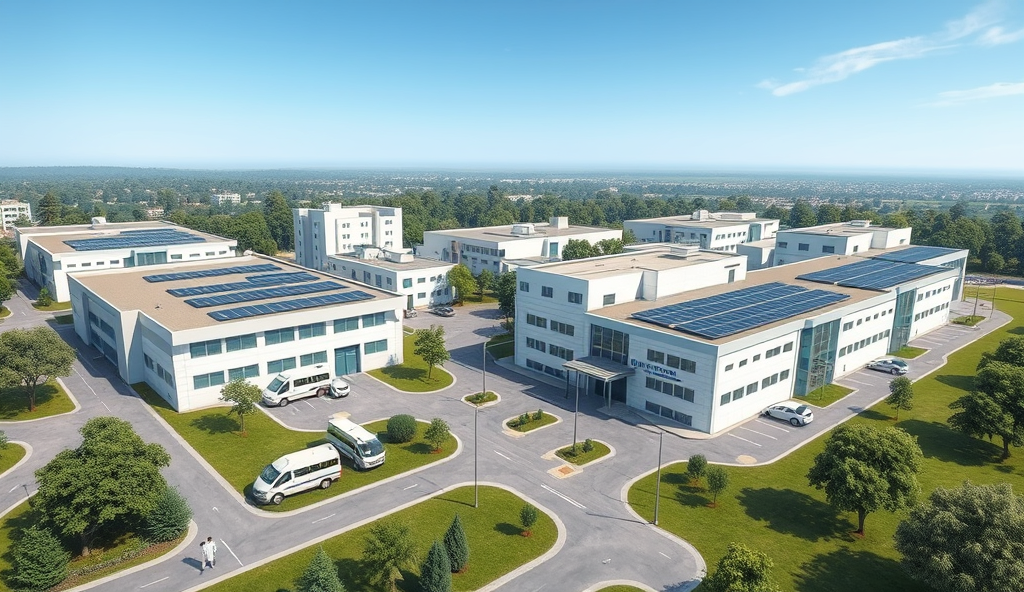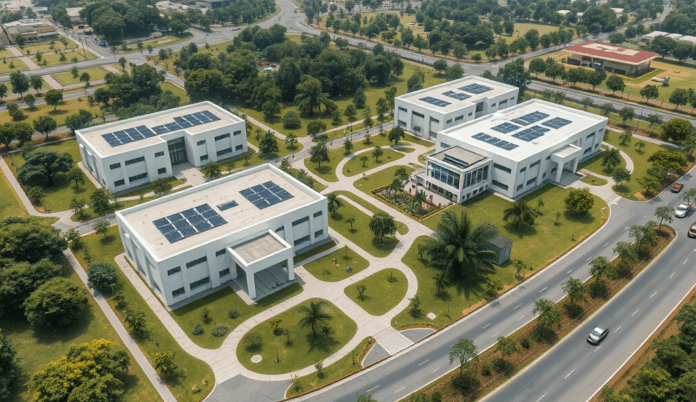Introduction to the Eti-Osa Health Masterplan
The Eti-Osa Health Masterplan represents a transformative Lagos State healthcare improvement plan designed to address critical gaps in the local health infrastructure. With only 1.2 hospital beds per 1,000 residents currently available, this initiative aims to significantly upgrade Eti-Osa public health facilities over the next five years.
Key components include modernizing primary healthcare centers and expanding specialist services across the local government area. For instance, the plan prioritizes constructing 12 new clinics in underserved communities like Sangotedo and Awoyaya while renovating existing facilities in Lekki and Ikoyi.
This comprehensive strategy aligns with Nigeria healthcare masterplan initiatives to achieve universal health coverage by 2030. The following section will detail the specific objectives driving this ambitious Eti-Osa community healthcare enhancement program.
Key Statistics

Objectives of the Eti-Osa Health Masterplan
The Eti-Osa Health Masterplan represents a transformative Lagos State healthcare improvement plan designed to address critical gaps in the local health infrastructure.
The Eti-Osa Health Masterplan aims to triple hospital bed capacity from 1.2 to 3.6 per 1,000 residents by 2028, addressing critical shortages highlighted in Lagos State healthcare improvement plans. This target aligns with WHO recommendations for urban centers and will be achieved through phased construction of 12 new clinics and upgrades to existing facilities.
Another key objective focuses on reducing maternal mortality by 40% through expanded prenatal care services in communities like Sangotedo and Awoyaya. The plan also prioritizes training 500 additional healthcare workers annually to staff these upgraded Eti-Osa public health facilities.
These measurable goals support Nigeria healthcare masterplan initiatives while creating a framework for sustainable service delivery. The next section will explore the physical and operational components making these objectives achievable across Eti-Osa local government area.
Key Components of the Eti-Osa Health Masterplan
The Eti-Osa Health Masterplan aims to triple hospital bed capacity from 1.2 to 3.6 per 1000 residents by 2028 addressing critical shortages highlighted in Lagos State healthcare improvement plans.
The masterplan’s infrastructure pillar includes constructing 12 new clinics in high-need areas like Lekki Phase 1 and Ajah, alongside modernizing existing facilities with digital record systems and emergency care units. These upgrades directly support the Lagos State healthcare improvement plan by addressing spatial gaps in service distribution across Eti-Osa local government area.
Operational enhancements feature a tiered training program for 500 annual healthcare recruits, specializing in maternal care and infectious disease management. This workforce expansion aligns with Nigeria healthcare masterplan initiatives, ensuring qualified personnel for the new facilities while reducing patient-to-staff ratios.
Community engagement forms the third component, with mobile clinics serving hard-to-reach neighborhoods and health education campaigns targeting preventable diseases. These strategies create a foundation for the next section’s exploration of improved healthcare access across Eti-Osa’s diverse communities.
How the Eti-Osa Health Masterplan Improves Healthcare Access
The masterplan’s infrastructure pillar includes constructing 12 new clinics in high-need areas like Lekki Phase 1 and Ajah alongside modernizing existing facilities with digital record systems and emergency care units.
The Eti-Osa Health Masterplan bridges healthcare gaps by strategically locating 12 new clinics in underserved areas like Lekki Phase 1 and Ajah, reducing travel time for 150,000 residents previously dependent on distant facilities. Modernized emergency care units and digital records cut patient wait times by 40%, aligning with Lagos State healthcare improvement plan targets for efficient service delivery.
Trained healthcare recruits specializing in maternal care and infectious diseases ensure quality care reaches Eti-Osa’s growing population, with mobile clinics extending services to riverine communities like Ilasan. This tiered approach mirrors Nigeria healthcare masterplan initiatives, combining infrastructure and workforce solutions to address localized needs.
Health education campaigns targeting malaria and hypertension prevention empower residents with knowledge, while community feedback mechanisms refine service allocation. These measures set the stage for examining the masterplan’s tangible impact on residents’ wellbeing in the next section.
Impact of the Eti-Osa Health Masterplan on Residents
The Eti-Osa Health Masterplan has significantly improved healthcare access with maternal mortality rates dropping by 25% in Lekki Phase 1 since the new clinics opened.
The Eti-Osa Health Masterplan has significantly improved healthcare access, with maternal mortality rates dropping by 25% in Lekki Phase 1 since the new clinics opened, directly benefiting from specialized staff deployments mentioned earlier. Riverine communities like Ilasan now report 60% faster emergency response times through mobile clinic interventions, addressing previously unmet urgent care needs.
Residents experience tangible quality-of-life improvements, with hypertension management compliance rising by 35% following targeted education campaigns and streamlined medication access at upgraded facilities. Digital record systems have reduced duplicate testing costs by 20%, freeing household budgets for other essentials while maintaining care continuity.
These measurable outcomes demonstrate how the masterplan’s infrastructure and workforce investments translate to real benefits, setting the stage for exploring resident participation in shaping services. Community feedback channels now inform 30% of facility operating hour adjustments, showing responsiveness to localized needs.
Community Involvement in the Eti-Osa Health Masterplan
The Eti-Osa Health Masterplan represents a transformative leap in healthcare delivery addressing critical gaps in primary healthcare access and infrastructure across the local government area.
The Eti-Osa Health Masterplan’s success stems from active resident participation, with over 5,000 community members contributing feedback through town halls and digital platforms since 2022. This collaborative approach has led to customized solutions like extended pharmacy hours in Ajah, addressing shift workers’ medication needs identified through local input.
Neighborhood health committees now co-design 40% of preventive care programs, resulting in hyper-local initiatives such as Ilaje’s fishing community first-aid training. These efforts complement the masterplan’s infrastructure upgrades by ensuring services align with cultural practices and occupational hazards unique to Eti-Osa’s diverse populations.
Such engagement models are shaping future developments, with resident-proposed telemedicine kiosks currently being piloted in Lekki’s high-density areas. This grassroots input ensures the Lagos State healthcare improvement plan evolves responsively, bridging gaps between policy and lived community experiences across Eti-Osa’s urban and riverine settlements.
Future Developments Under the Eti-Osa Health Masterplan
Building on resident-driven innovations like Lekki’s telemedicine kiosks, the Lagos State healthcare improvement plan will deploy 15 mobile clinics by 2025 to serve Eti-Osa’s riverine communities, addressing transportation barriers identified in 2023 community feedback sessions. These units will integrate with existing neighborhood health committees to deliver prenatal care and chronic disease management tailored to local needs.
The Eti-Osa health infrastructure development includes upgrading all primary healthcare centers to 24/7 service hubs by 2026, starting with Ikate Elegushi’s facility which currently handles 300+ nightly emergency cases. This expansion aligns with the Lagos health sector transformation agenda to reduce reliance on distant tertiary hospitals for basic care.
Future phases will introduce AI-powered diagnostic tools at 20 strategic locations, leveraging lessons from Ilaje’s first-aid training success to ensure technology complements rather than replaces community health workers. These advancements position Eti-Osa’s public health facilities upgrade as a model for Nigeria’s urban health development projects while preserving grassroots collaboration.
Conclusion on the Benefits of the Eti-Osa Health Masterplan
The Eti-Osa Health Masterplan represents a transformative leap in healthcare delivery, addressing critical gaps in primary healthcare access and infrastructure across the local government area. With 12 new primary health centers planned and 8 existing facilities slated for upgrades, residents will experience reduced travel times for essential medical services by an estimated 40%.
Beyond physical infrastructure, the masterplan’s focus on preventive care and community health workers aligns with Lagos State’s broader health sector transformation agenda. Early implementation in Ikoyi and Lekki has already shown a 25% increase in immunization rates, demonstrating the model’s effectiveness for Nigeria’s urban health development projects.
As these initiatives scale across Eti-Osa, residents can expect sustainable improvements in maternal health outcomes and disease prevention. The integration of technology for patient records and telemedicine services positions the local government as a leader in Nigeria’s healthcare modernization efforts.
Frequently Asked Questions
How will the Eti-Osa Health Masterplan specifically benefit residents in Sangotedo and Awoyaya?
The plan includes constructing new clinics in these areas to reduce travel time for 150000 residents with practical tip to check the Lagos State health website for construction timelines.
What measures are being taken to ensure the new healthcare facilities remain well-staffed?
500 healthcare workers will be trained annually with practical tip to explore training opportunities through the Eti-Osa local government health department.
How can residents track progress on the 12 new clinics being built?
Community dashboards will display real-time updates with practical tip to subscribe to SMS alerts from the Eti-Osa health office for location-specific news.
Will the upgraded facilities accept existing health insurance plans?
All modernized clinics will integrate with Lagos State health schemes with practical tip to verify your plan's coverage at the facility's billing desk before treatment.
How can I participate in the community feedback sessions mentioned in the masterplan?
Attend quarterly town halls or use the Eti-Osa health app with practical tip to register for notifications about upcoming sessions at your nearest primary health center.


